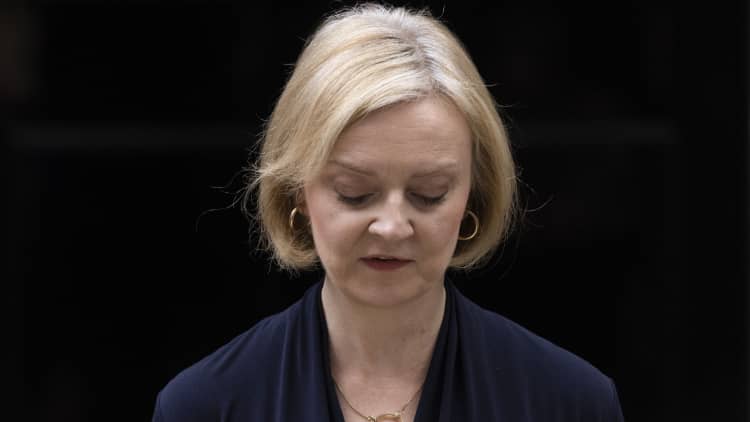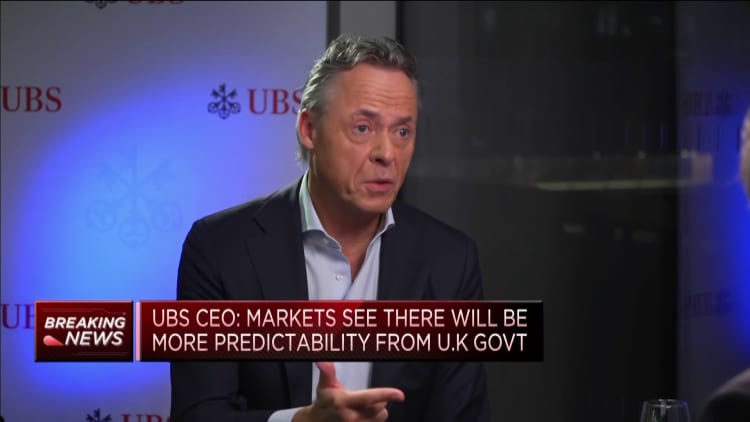Traders in London.
DANIEL LEAL-OLIVAS | AFP | Getty Images
LONDON — The British pound is on firmer footing since the appointment of new Prime Minister Rishi Sunak, but Wall Street still sees further vulnerability over the next 12 months.
After falling to a record low against the dollar of below $1.04 on Sep. 25 following the disastrous fiscal policy announcements that would eventually lead to the resignation of former Prime Minister Liz Truss, sterling had recovered to around $1.139 by Thursday morning, but remains down over 15% year-to-date.
Sunak’s planned return to a more traditionally conservative fiscal policy agenda mostly stabilized markets and reduced expectations for more aggressive interest rate hikes from the Bank of England, offering respite to the currency.
In a note Monday, Deutsche Bank vice president and FX strategist Shreyas Gopal said the “crisis” chapter on the U.K. can now close, with the pound now likely to trade as a “normal” currency, but noted that downward pressure from large external financing needs and low real rates remains.
“The U.K.’s external financing needs remain large and, on current market pricing, real yields are still too low compared to other major currencies. As long as the global risk environment remains weak this leaves the pound vulnerable and the likely trend lower,” Gopal said.
The Bank of England is expected to raise interest rates by 75 basis points on Thursday, its biggest hike since 1989, but economists expect the central bank to adopt a more dovish tone and ultimately fall short of the terminal rate of almost 5% priced in by the market.

“In all, we remain bearish on the pound and believe GBP weakness will return for the rest of the year,” Gopal said.
“In the volatility space, the market has rightly assessed that the tails have narrowed for the pound, in line with our view, and we take profit on our short volatility recommendations from earlier this month.”
The U.K.’s long-running current account deficit has been exacerbated by soaring energy prices, which have added almost 2% of gross domestic product to the country’s trade deficit over the past year while placing a historic squeeze on household incomes. U.K. real wages fell at a record rate in the second quarter and inflation hit a 40-year high of 10.1% in September.
Gopal suggested that as a result, private sector savings may fall further in the coming quarters in order to sustain consumption of essential goods, while the government’s new fiscal plans, set to be laid out in full later this month, will likely mean public sector borrowing will exert less downward pressure on the trade balance.
The government has also promised further details on a more targeted version of the Energy Price Guarantee scheme, which will reduce government spending but will further cement the U.K.’s likely recession.
“This should lead to import compression and a (cyclical) improvement in the current account balance — though as a fraction of GDP this impact is likely to be less pronounced,” Gopal said.

“Beyond this, two other offsets include the recent fall in gas prices, with the further from their peak that gas prices settle the better for the external accounts.”
While the recent news flow has been more positive for the U.K. current account, Deutsche Bank does not believe it will prevent external deficits growing “wider than usual and wider than other developed market peers.”
A dovish shift in monetary policy would be seen as negative for the pound given how much tightening is priced in. What’s more, the removal of fiscal support during a particularly tough economic downturn may be “easier said than done,” according to Goldman Sachs.
“Taking these things together, we are revising our Sterling forecasts in a more positive direction, but still expect some further GBP underperformance ahead,” Kamakshya Trivedi, head of global FX, rates and EM strategy at Goldman, said in a note last week.
Goldman last week upgraded its three-, six- and 12-month outlooks for the pound to $1.10, $1.11 and $1.22 from a previous projection of $1.05, $1.08 and $1.19.
Not the last crisis for the UK
Despite the persistent vulnerabilities, however, analysts do not see a return to the record lows seen in late September. In a note Tuesday, BMO Capital Markets suggested that a less hawkish posture from the Bank of England was unlikely to trigger an aggressive near-term sell-off of the pound, nor would a more restrictive stance create buying pressure.
“The U.K. economy and the GBP still have numerous macroeconomic and balance of payments (BoP) headwinds to face. However, one of the more appealing features of the U.K. macro picture is that it’s generally beneficial to be the first to have had a crisis and emerge from it on the other side,” said Stephen Gallo, European head of FX strategy at BMO.
On a longer-term horizon, however, Gallo said the Canadian investment bank was skeptical that 2022 will have marked the last crisis for the U.K., whether around the currency, balance of payments or fiscal policy.
“We would argue that overall UK risk premia should be higher today than during the prior 10-year period. However, the most aggressive phase of the re-pricing seems to be fading in the distance of the rearview mirror,” he added.
















































































